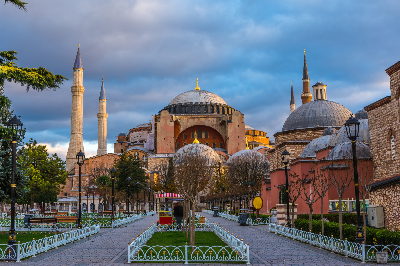
©
У Туреччині стартував один із наймасштабніших реставраційних проєктів останніх десятиліть — відновлення головного купола Софійського собору, більш відомого як Айя-Софія. Цей архітектурний шедевр візантійської епохи нараховує 1 486 років, височіє в самому серці історичного району Султанахмет у Стамбулі та є не лише символом "золотої доби" Візантії, а й важливою пам’яткою світового культурного спадку. Реставраційні роботи ведуться без зупинки богослужінь. Їх головна мета — зберегти та актуалізувати унікальну історико-архітектурну спадщину, не змінюючи її автентичного вигляду. Щоб підвищити сейсмостійкість споруди, фахівці укріплюють центральний купол, водночас дбайливо захищаючи цінні мозаїки від будь-яких пошкоджень — роботи виконуються ззовні. Один із технічних новаторських аспектів проєкту — тимчасова металева конструкція висотою 43,5 м, зведена навколо купола, що дозволяє продовжувати богослужіння, не перериваючи ремонтні процеси. Додатково встановлено спеціальний баштовий кран, спроєктований для точного й безпечного переміщення матеріалів. Айя-Софія також отримала цифрову модель — усі елементи споруди були оцифровані у форматі 3D. Це дало змогу провести ґрунтовне дослідження конструкцій, змоделювати можливі сценарії сейсмічних впливів і розробити оптимальні методи захисту. Окрім основної святині, реставраційні роботи охоплюють і прилеглі архітектурні об’єкти — мавзолеї, початкову школу, вежу-годинник. Загальна вартість реставраційного проєкту оцінюється в 350 тис. євро, а його тривалість становить 600 днів. Завдяки використанню сучасних технологій та науково обґрунтованому підходу турецька влада прагне не просто зберегти цей культурний спадок, а й передати його наступним поколінням у максимально автентичному вигляді.
A Large-Scale Restoration of the Hagia Sophia Dome Has Begun in Istanbul
Turkey has launched one of the largest restoration projects in recent decades — the restoration of the main dome of the Hagia Sophia, an architectural masterpiece from the Byzantine era. This 1,486-year-old monument, located in the heart of Istanbul’s historic Sultanahmet district, is not only a symbol of the "Golden Age" of the Byzantine Empire but also an important part of the world’s cultural heritage. The restoration works are being carried out without interrupting religious services. The primary goal is to preserve and revitalize this unique historical and architectural heritage while maintaining its authentic appearance. To enhance the seismic resilience of the structure, specialists are reinforcing the central dome while carefully protecting the valuable mosaics from any damage — all work is being carried out externally. One of the innovative aspects of the project is the temporary steel structure, 43.5 meters in height, erected around the dome, allowing religious services to continue uninterrupted while restoration efforts proceed. Additionally, a specialized tower crane has been installed, designed to move materials with precision and safety. Hagia Sophia has also received a digital model, with all the architectural elements documented in 3D format. This has enabled a thorough analysis of the structure, modeling potential seismic impacts, and developing effective protection methods. In addition to the main sanctuary, the restoration project also includes adjacent architectural elements such as the mausoleums, the elementary school, and the clock tower. The total cost of the restoration project is estimated at 350,000 euros, and its duration is set for 600 days. Thanks to the use of modern technologies and a scientifically grounded approach, Turkish authorities aim not only to preserve this cultural heritage but also to pass it on to future generations in its most authentic form.
1037